Earth Resources Midterm
1/212
There's no tags or description
Looks like no tags are added yet.
Name | Mastery | Learn | Test | Matching | Spaced |
|---|
No study sessions yet.
213 Terms
under what circumstances does the quantity of reserves of a given commodity increase? decrease?
the quantity of a reserve can increase if there is a new discovery or technological advancements and it decreases when it is mined out.
what are renewable and non-renewable resources? list three of each
renewable resources are those materials that are replenished on short timescales of a few months/years. these include the organic materials from plants and animals, as well as the energy we draw from wind, flowing water, and the sun’s heat.
non-renewable resources are those materials of which earth contains a fixed quantity and which are not replenished by natural processes operating on short timescales. these include oil, natural gas, copper, and other mineral products we dig and pump from earth.
when the price of a mineral commodity of fossil fuel rises, what happens to the reserves
the reserves increases when the price (market value) of a fossil fuel because more will be economic to extract
define in simple terms the difference between a reserve and a resource
a resource is the concentration of naturally occurring solid, liquid, or gaseous material, in or on earth’s crust, in such form and amount that economic extraction of a commodity from the concentration is currently or potentially feasible. a reserve is the part of the resources that can be economically and legally extracted at a given time. the resources must meet economic, legal, and environmental constraints
explain how market prices have an impact on the quantity of reserves for a given mineral or commodity
the quantity of a reserve increases as the market value of a mineral/commodity rises, and decreases as the market value falls
how do commodity resources become reserves? give two examples
resources can become reserves when there is a technological advancement that allows for economic extraction. for example this occurred when a new bulk mining process in the beginning of the 20th century allowed for copper deposits to become reserves. another example of this is after WWII, when iron reserves were running low, a new mining technology allowed for “taconites” to be worked with and they now supply much of the iron in the US.
what is a mineral or commodity reserve
a reserve is the part of the resources that can be economically and legally extracted at a given time. the resource must meet economic, legal, and environmental constraints.
what is a mineral or commodity resource
a resource is the concentration of naturally occurring solid, liquid, or gaseous material in or on the earth’s crust, in such form and amount that economic extraction of a commodity from the concentration is currently or potentially feasible
what is one watt equivalent to
a watt is equivalent to work done at a rate of one joule per second (1 J / 1 sec)
what constraints influence whether or not a resource is a reserve
constraints include economic, environmental, and legal boundaries. this includes land ownership, the presence of endangered animals or plants, potential carcinogenic effects of mining, and more on top of the economic factor.
what is the doubling time for commodity consumption growing at 3 % per year
doubling time is calculated as the natural log of growth. thus for doubling time it is 0.7/rate for the time, for a growth rate of 3% or 0.03, the doubling time is 0.7/0.03 which is about 23 years.
what is the time required for a factor of 10 increase in commodity consumption growing at 3% per year
the natural log of 10 divided by rate of growth. thus for a factor of 10 increase it is 2.3/rate for the time. for a growth rate of 3% or 0.03, the factor of 10 increase is 2.3/0.03 which is about 77 years.
what are the units of reserve to production ratio
the reserves to production ratio is the reserves available (eg Gt) divided by the rate of production (eg Gt/yr). thus the unit is time, and the time that is calculated is the time the commodity would run out if no new reserves are proven and if production continues at a constant rate.
what are the two assumptions when calculating reserves to production ratio
1) no new reserves are proven and 2) production continues at a constant rate
acid rain is considered one of the most serious forms of pollution. what causes it?
when sulfur-bearing minerals in coal are burned, sulfur oxides are released which combine with water vapour in the atmosphere to form sulfuric acid. nitrogen oxides, which react with water vapour to form nitric acid, are created from high temperature combustion (like the burning of fossil fuels) in the atmosphere with high levels of nitrogen. these two acids in the atmosphere become part of the rainfall, and as acids, lower the pH.
list two environmental impacts due to use of coal in power generation and manufacturing
use of coal in power generation leads to acid rain, resulting from sulfur oxides/nitrogen being turned into acid in rainfall (nitric/sulfuric acid).
strip mining for coal leaves mounds of waste material that have no vegetation and are too steep to farm, thus devastating large plots of land.
contributes to greenhouse effect when burned by increasing carbon dioxide in the atmosphere,
when burned trace amounts of mercury are released, and coal combustion is the world’s greatest source of mercury pollution
what are the two main methods of coal mining? which is safer for those involved in production?
the two main methods of coal mining are underground mining and surface mining. surface mining is safer for those involved in producing coal.
what is one acid in acid rain
the acids in acid rain are sulfuric and nitric acid.
what is the difference between external and internal costs of resource use and pollution
internal costs are costs taken on by the producer for the resource use and pollution they partake in. external costs are costs taken on by the public for the resource use and pollution of a producer.
what are two examples of change from external to internal costs
an example of internalising an external cost would be for example mandating companies to offset their carbon emissions. this changes the external cost, climate change for everyone, to an internal cost, a fee for the company.
another example is in early london where people chucked human waste into the streets. everyone bore the cost of this process through the smell. the government internalised this external cost by making people pay a tax for creating a central sewer system. instead of making other people pay with the smell, the people creating waste had to pay.
how have US government regulations on mercury emissions affected the rate of repalcement versus renovation of older coal fired power plants in the US
the US govt made regulations that all new coal fired power plants could not emit any mercury, but this left the loophole of the old power plants being fine to emit mercury. thus, people just renovated old coal power plants instead of replacing them or making new ones.
in the US, which method is used to mine most of the coal in the high plains rocky mountain region? in general is the coal in this region higher or lower grade than the coal obtained from the Appalachians in the previous century?
strip mining is used to mine most of the coal in the high plains rocky mountains region. in general the coal in this region is lower grade than the Appalachian coal, the area is richest in sub-bituminious coal whereas the Appalachian coal is bituminous.
what is pH?
a measure of hydrogen ions. it is the -log10 of H+ ion concentrations in moles per liter.
in acid rain, is the pH higher or lower than normal
the pH is lower than normal, since the rain is more acidic
what is the largest source of human mercury emissions to the atmosphere
the largest source of mercury emissions to the atmosphere is from coal combustion in power plants, as it releases trace amounts of mercury
around which ocean basin (arctic, atlantic, indian, pacific…) are most sub-aerial volcanoes found?
most volcanoes are found along a belt called the “ring of fire” that encircles the pacific ocean
in the content of crystalisation of magmas, what are incompatible elements
as magma crystalises, the incompatible elements are those that don’t fit easily into the crystal structures of minerals (because of size or charge) and thus stay preferentially in the liquid phase.
is contential crust thicker or thinner than oceanic crust
the continental crust is thicker than the oceanic crust
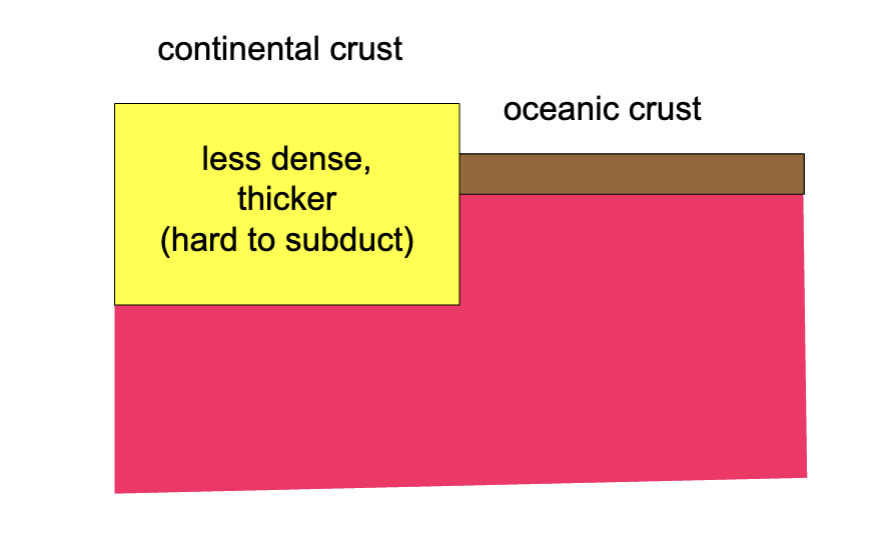
is oceanic crust denser or less dense than continental crust
oceanic crust is more dense than continental crust
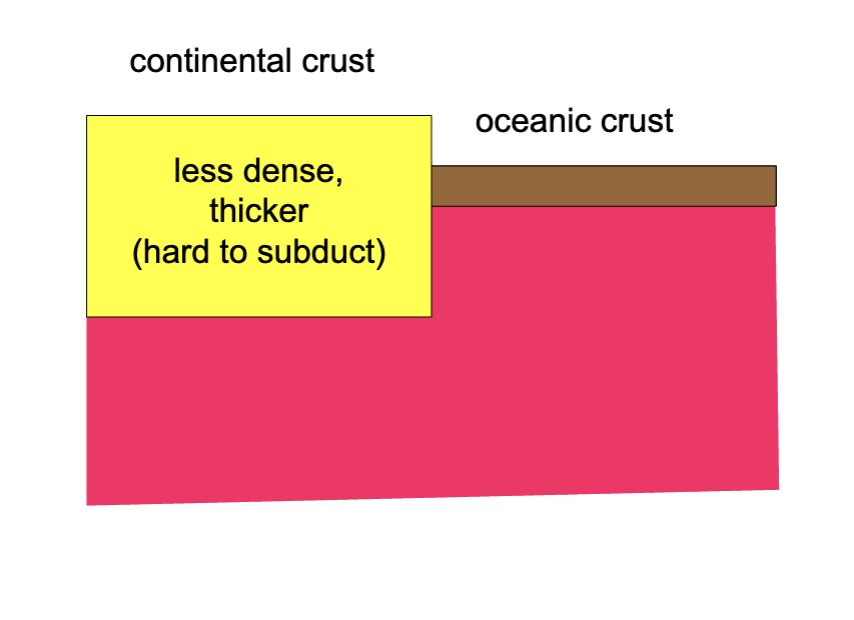
name four of the twelve most abundant elements on earth
some of the most abundant elements on earth include nitrogen, oxygen, silicon, aluminum, and iron
what are two natural sources of thermal energy (heat) on earth?
the heat from the sun and the heat in the earth’s interior which is given off by a natural decay of radioactive elements
what kind of plate boundary forms the mid-ocean ridges? what is the heat source for submarine hydrothermal vents along the mid-ocean ridges?
divergent plate boundaries, or spreading zones, form the mid-ocean ridges, which are where new magma is brought upward. the heat source for these submarine hydrothermal vents is from the heat given off by the natural decay of radioactive elements in the earth’s interior (like uranium and potassimum) which is then dissipated and carried upward through large convection cells in the mantle, where a lot of the heat is released at these mid-oceanic ridges.
what property of the earth’s magnetic field was crucial in the discovery of seafloor spreading.
seemingly random reversals in the polarity of the earth’s magnetic field were crucial in the discovery of seafloor spreading. magma particles point towards one pole or the other, and then “freeze” into place during cooling. the stripes of magma particles facing different ways were indicative of a reversal of polarity. the reason they were crucial is because scientists reading magnetisation maps realised that these stripes were symmetrical along lines, which they determined to be spreading centers, and they were able to figure out that the seafloor was spreading at these points.
when they are molten, which are hotter, mafic magmas or felsic magmas?
in molten form, mafic magmas are hotter than felsic magmas.
which have more Mg and Fe, mafic igneous rocks or felsic igneous rocks?
mafic igneous rocks have more Mg and Fe and are rich in compatible elements, these make up the oceanic crust.
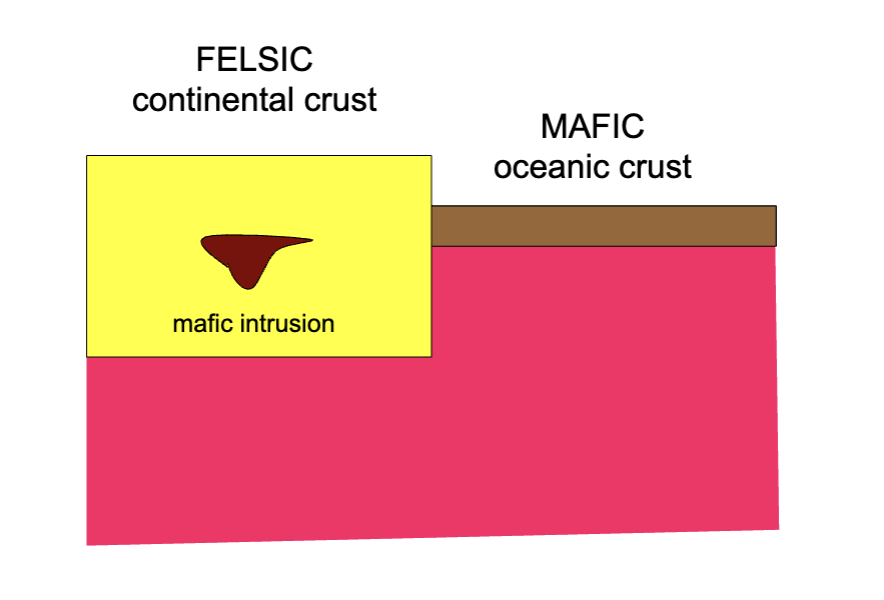
which have more Al, Si, Na, and K, mafic igneous rocks or felsic igenous rocks?
felsic igenous rocks have more Al, Si, Na, and K and are rich in INcompatible elements, these make up the contential crust
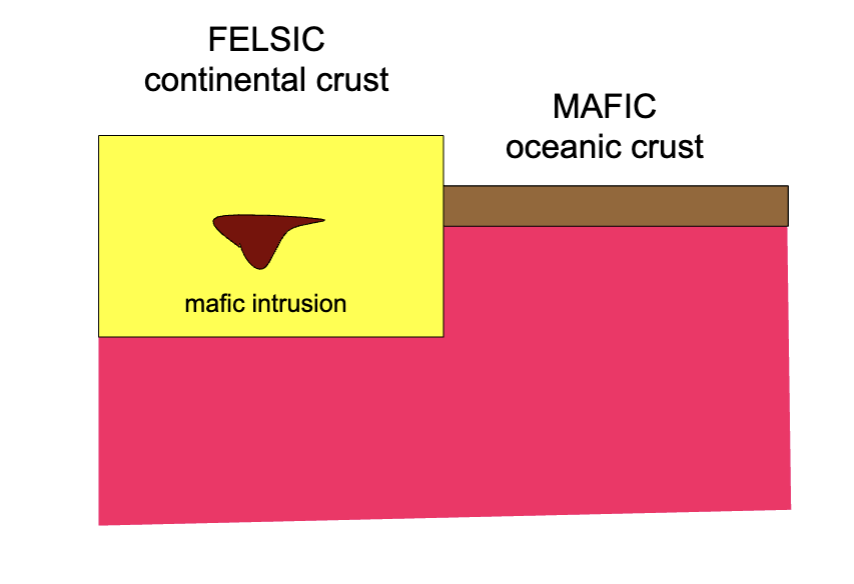
are mafic or felsic igneous rocks more likely to have compatible elements
mafic elements are richer in compatible elements, and felsic elements are richer in incompatible elements
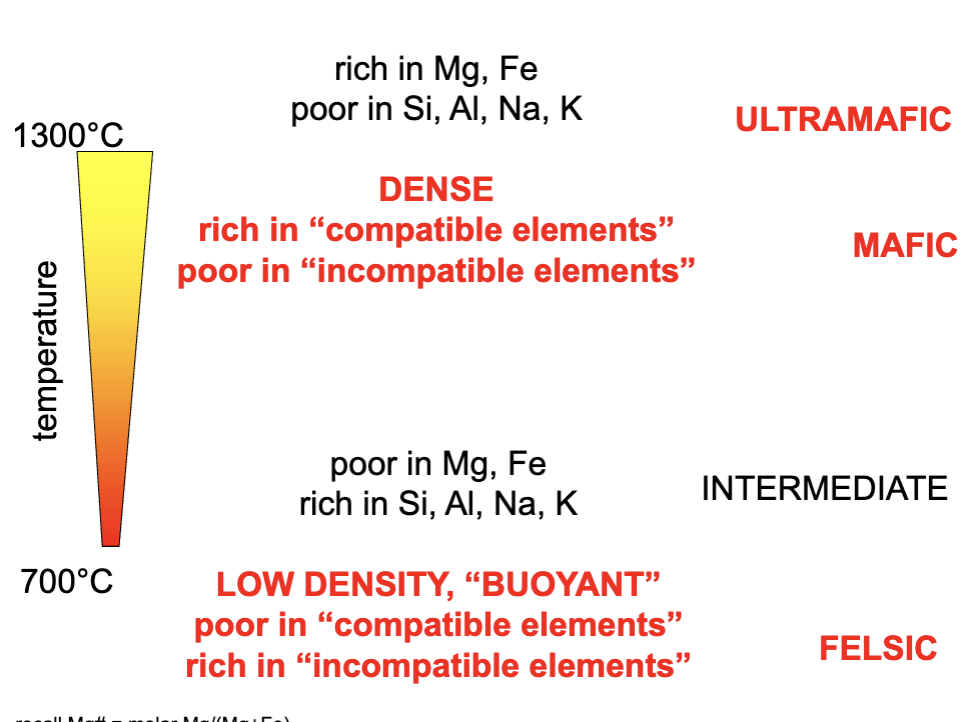
where would you expect to find igenous rocks with more SiO2, in the oceanic crust or the contential crust?
SiO2 would be more likely to be found in the contential crust. it is a compatible element, and therefore more likely to be found in the less dense, felsic rock.
why is it unlikely to find coal deposits in igneous rocks?
igenous rocks form when magma cools and crystalises, but coal is not derived from molten material. coal is sedimentary rock, with vegetal origins.
with the exception of some small fragments thrust onto the continents, the oldest oceanic crust on earth is less than 200 million years old. the earth has had oceans and oceanic crust for several billion years? where did the older oceanic crust go?
at subduction zones, oceanic crust slides under other tectonic plates and sinks back into the mantle.
below the surface layers affected by the weather and short term climate change, how does temperature vary with depth in the solid crust of the earth? how does temperature vary with depth in large ocean basins? how does this affect the stability of gas hydrates? how does this affect potential methods for storage of CO2 captured from exhaust gas at power plants?
temperature increases into the solid crust of the earth. the opposite occurs in the oceans, as you go deeper in the ocean, temperature decreases and pressure increases. gas hydrates are stable at high pressure and low temperature, and thus are more stable deeper in the ocean. CO2 is more dense than water at temperatures less than 10 C and high pressures, so there is a potential to store CO2 in puddles on the seafloor.
one type of meteorite carbonaceous chondrites is very helpful in estimating the bulk composition of the earth. what are some similarities and differences between the composition of carbonaceous chondrites and the composition of the solar atmosphere?
compared to the solar atmosphere, carbonaceous chondrites are depleted in elements that form gases at low temperature, thought to have been blown outward by the “solar wind” during condensation of the solar nebula.
what are black smokers and how do they form
black smokers are vents on the seafloor from which hot hydrothermal fluids are issued. upon entering the cold ocean waters, these fluids may rapidly mix, cool, and precipitate very fine iron and other metal sulfides that appear as black smoke. these vents form near spreading centers when cold sea water percolates through the ocean crust, is heated by hot magma, and reemerges because of the pressure as hydrothermal fluids.
what are the four main layers of the earth’s interior below the oceans and atmosphere, two composed mainly of silicates plus some metal-oxides and two composed mainly of metallic compounds? which one is liquid.
the four main layers consist of the inner core, solid iron, the outer core, liquid iron, the mantle (composed of Fe-Mg silicates) and the crust.
what are the three main types of tectonic plate boundaries
divergent plate boundaries (spreading centers)
convergent plate boundaries (where plates collide)
transforming plate boundaries (where plates slide past one another)
what caused the formation of banded iron formations in ocean sediments billions of years ago
photosynthetic organisms created oxygen which reacted with iron dissolved in sea water to form iron oxide minerals and this created the banded formations in ocean sediments
what is a deep sea hydrothermal vent? along what sort of plate boundary are they located? what is the source of heat? how do ore deposits form in this setting?
deep sea hydrothermal vents are located along divergent plate boundaries. the source of their heat is from the natural decay of radioactive elements in the earth’s interior like uranium and potassium. the earth dissipates this heat through generation of large convection cells in the mantle, and the cells carry much of this heat upwards, and deep sea hydrothermal vents are places where this heat is released.
what is a subduction zone? what is a convergent plate margin?
a convergent plate margin is a place where two plates come together. a subduction zone is a convergent plate margin where one plate sinks into the mantle underneath the other plate.
what is an oceanic spreading ridge? what is a divergent plate margin?
an oceanic spreading ridge is a divergent plate margin, aka a spreading zone, where new oceanic crust is formed as new magma is brought upward
where is oceanic crust formed
oceanic crust is formed at mid-oceanic ridges, which are a divergent plate boundary
what was the role of measurements of magnetisation of the seafloor in the discovery of plate tectonics?
seemingly random reversals in the polarity of the earth’s magnetic field were crucial in the discovery of seafloor spreading. magma particles point towards one pole or the other, and then “freeze” into place during cooling. the stripes of magma particles facing different ways were indicative of a reversal of polarity. the reason they were crucial is because scientists reading magnetisation maps realised that those stripes were symmetrical along lines, which they determined to be spreading centers, and they were able to figure out that the seafloor was spreading at these points.
new oceanic crust is continually produced at mid-ocean ridges. is the earth expanding? if not, where is the old oceanic crust going?
the earth is not expanding, instead at subduction zones, the old oceanic crust sinks back into the mantle.
given that the earth is 4.56 billion years old, why is there no oceanic crust older than 180 million years? where did the older oceanic crust go?
at subduction zones, oceanic crust slides under other tectonic plates and sink back into the mantle.
which of the two types of crust on earth (basaltic ocean crust or continental crust) is denser?
basaltic ocean crust is denser
what abundant gas in the earth’s atmosphere was almost absent in the early atmosphere
oxygen (and nitrogen) are abundant today but almost absent in the early atmosphere
what is the most abundant gas in the atmosphere of venus and mars ?
the most abundant gas in the atmosphere of venus and mars is carbon dioxide
what is the main resevoir for thr CO2 that was in the earth’s early atmosphere?
the main resevoir for the CO2 that was in the earth’s early atmosphere is in sedimentary rocks (sedimentary deposits)
to the nearest 1 billion people, what is the human population of the earth now,
A. 6 billion, B. 7 billion, C. 8 billion, D. 9 billion
C. 8 billion
approximately what was the 2004 UN medium projected peak population toward the end of this century
A. 7 billion, B. 8 billion, C. 9 billion, D. 10 billion
C. 9 billion
how about the 2022 UN medium projected population in 2100>
A. 8 billion, B. 9 billion, C. 10.5 billion, D. 11 billion
C. 10.5 billion
in the past 67 years, global population has increased by a factor of,
A. 1.5, B. 2, C. 2.5, D. 3
D. 3
in the past 67 years, US population has
A. remained the same, B. increased by a factor of 1.5, C. increased by a factor of 2, D. increased by a factor of 2.5
C. increased by a factor of 2
over the past century, global human energy consumption has increased by a factor of about
A. 2, B. 4, C. 8, D. 16
D. 16
over the past 150 years, global per capita energy consumption has increased by a factor of
A. 3, B. 6, C. 9, D. 18
C. 9
when was the last year in which per capita energy consumption in the US was equal to the current global average of about 2500 watts per person
A. 1776, B. 1850, C. 1890, D. 1920, E. 1950
A. 1776
what is an external cost,
A. cost to manufacturer of installing pollution controls
B. money paid for commodities from an external source
C. impact of producing a commodity borne by “the public”
C. impact of producing a commodity borne by “the public”
the ratio of incoming solar energy to total global energy consumption is approximately
A. 250, B. 500, C. 1000, D. 2000, E. 4000
D. 2000
pH is
A. H+ ion concentration in water (in moles per liter)
B. log10 of H+ ion concentration (in moles per liter)
C. -log10 of H+ ion concentration (in moles per liter)
C. -log10 of H+ concentration (in moles per liter)
if pH is high, H+ concentration is low (basic)
if pH is low, H+ concentration is high (acidic)
in acid rain, the pH is
A. lower than normal
B. higher than normal
A. lower than normal
emissions from burning coal, smelting copper, etc that cause acid rain include
sulfur oxides and nitrogen oxides
what are the two largest land owner groups in alaska
the federal government is the largest land owner in alaska, followed by the state of alaska.
which is not one of the four main layers in the solid earth,
A. inner core, B. outer core, C. cortex, D. mantle, E. crust
c. cortex
the inner core is solid and the outer core is liquid
what is the earth’s core made of
mainly Fe and Ni
what is the earth’s mantle made of
mainly Mg-rich silicate minerals
how do we (think we) know about the composition of the mantle
composition of the solar atmosphere from absorbance, composition of ancient meteorites (carbonaceous chondrites), composition of fragments and exposed massifs of mantle rocks
true or false: compared to the solar atmosphere, carbonaceous chondrites are depleted in elements that form gases at low temperature, thought to have been blown outward by the “solar wind” during condensation of the solar nebula
true
true or false: divergent plate boundaries are spreading centers, aka mid ocean ridges making new crust (usually, oceanic crust)
true
true or false : convergent plate boundaries are subduction zones , subducting plates (but new volcanic arc crust forms above subduction zones
true
draw the three plate boundaries
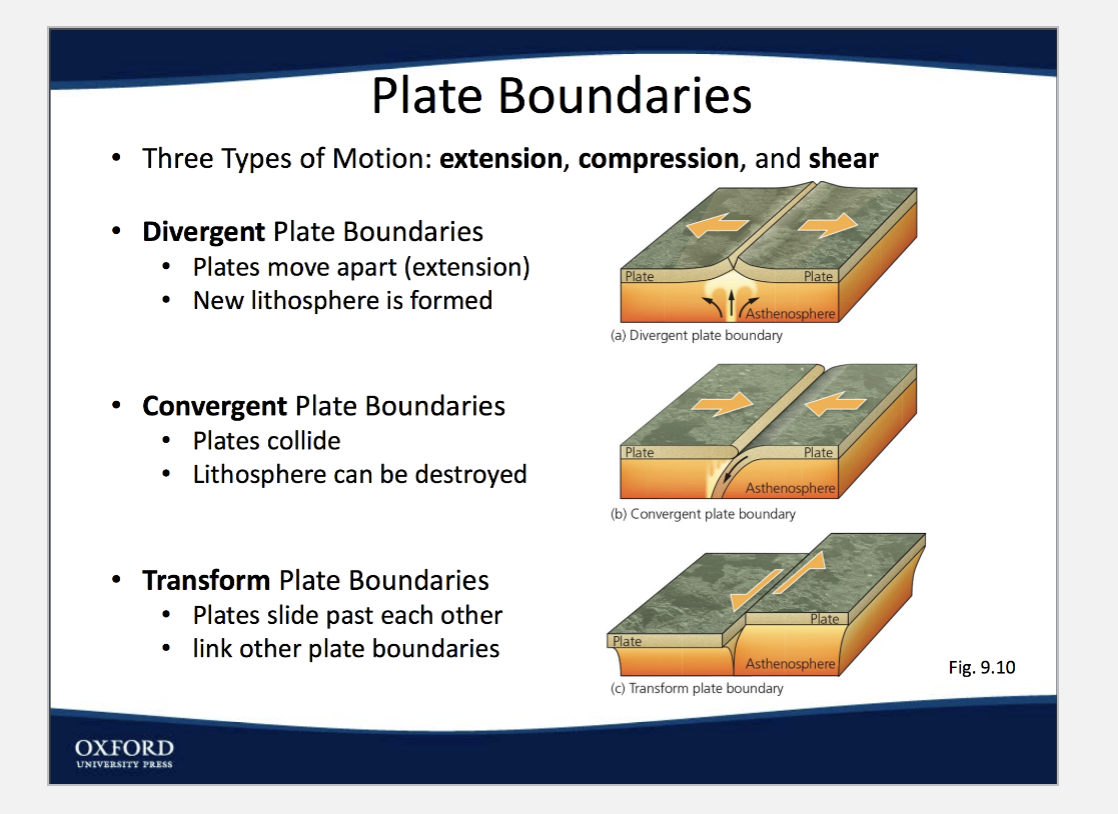
where are compatible elements,
A. mafic rocks (oceanic crust, mafic intrusions)
B. felsic rocks (volcanic arcs, continental crust)
mafic rocks (ocean crust, mafic intrusions)
where are incompatible elements
A. mafic rocks, (ocean crust, mafic intrusions)
B. felsic rocks (volcanic arcs, continental crusts)
felsic rocks (volcanic arcs, continental crust)
diagram the difference between reserves and resources

what are the units of reserves to production ratios
A. energy, B. tons, C. time, D. velocity
C. time
what are the main three types of rocks
igneous, metamorphic, and sedimentary
how was seafloor spreading discovered,
A. marine magnetic sediments
B. measurements of magnetism in lake sediments
C. looking out the window of a submarine
D. GPS measurements
A. marine magnetic measurements
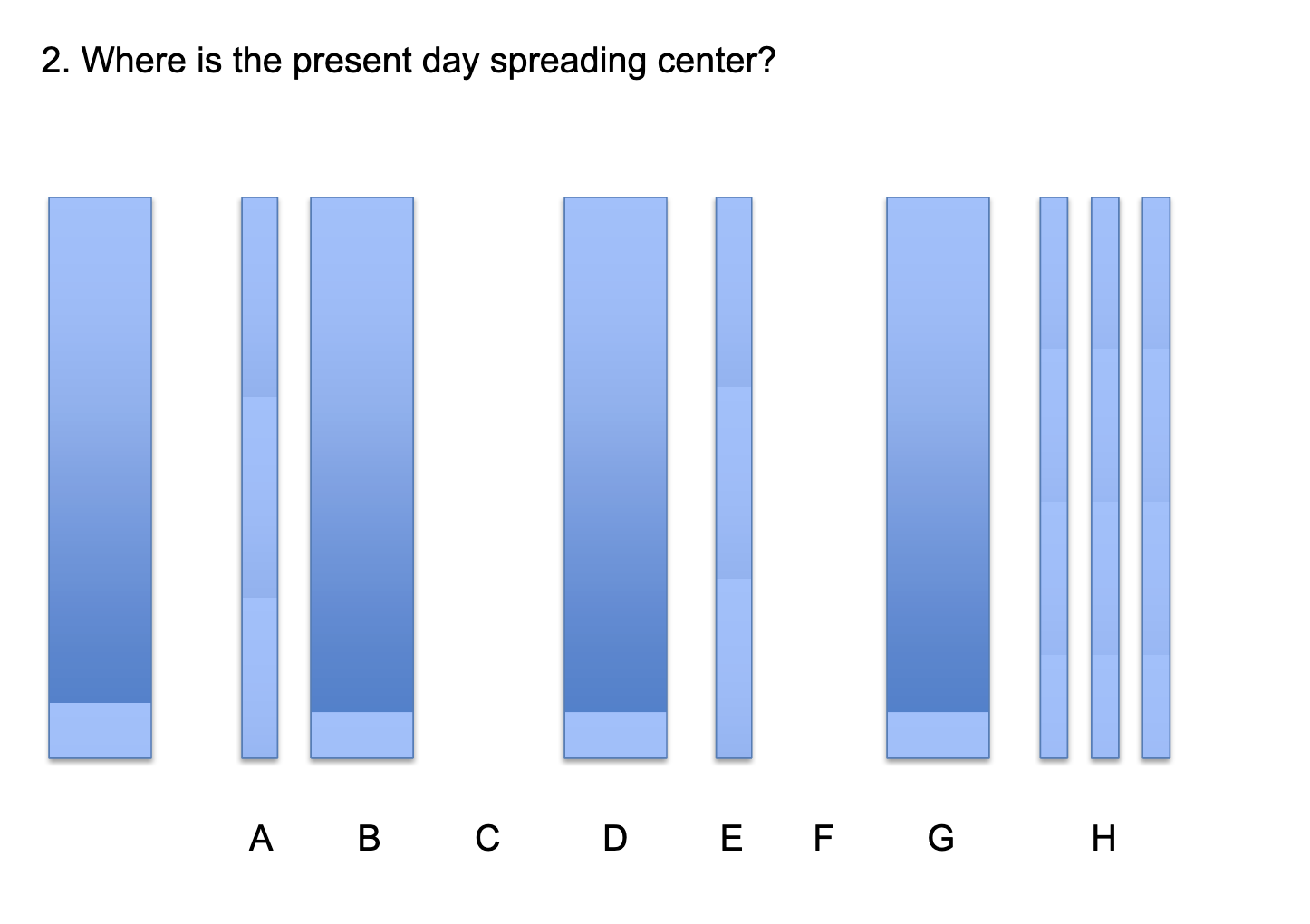
C, about which the spreading is symmetric
subduction zones are also called
A. divergent plate boundaries
B. convergent plate boundaries
C. transform plate boundaries
B. convergent plate boundaries

more felsic (cooler)
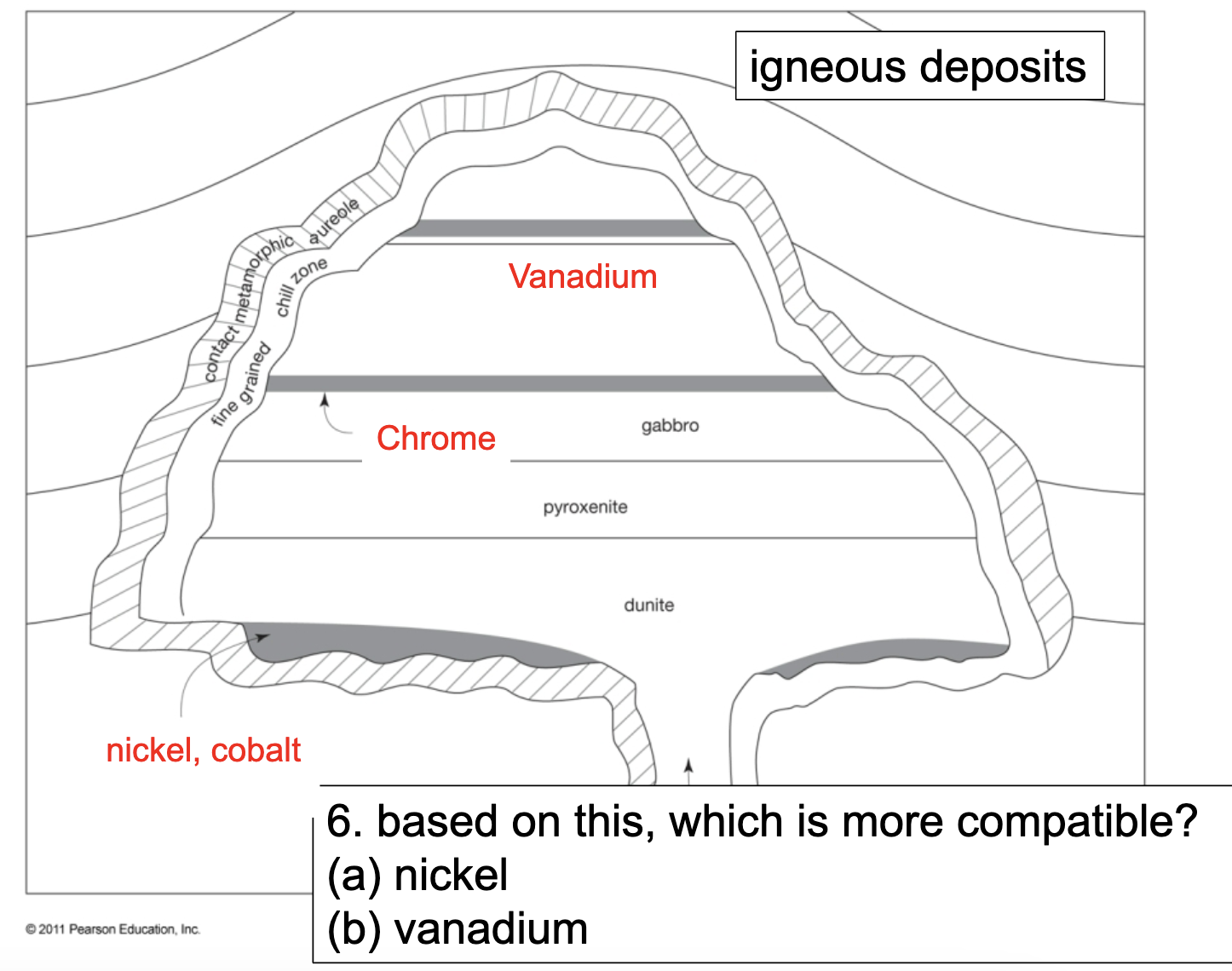
given that the top of the intrusion is more felsic, is vanadium or nickel more compatible
since felsic crust is richer in incompatible elements, vanadium is incompatible. thus, nickel is more compatible.
what are the four types of sedimentary deposits
clastic, chemical, biogenic, evaporite
most currently used energy resources and reserves are from,
A. igenous rocks
B. metamorphic rocks
C. clastic and biogenic sedimentary rocks
D. evaporites
C. clastic and biogenic sedimentary rocks
what gases are major consitutents of earth’s atmosphere, but minor on venus and mars
oxygen and nitrogen —> lack of photosynthesis
why are biogenic sedimentary deposits with reduced hydrocarbons good for energy production?
we can burn them! combustion AKA oxidation
reduced carbon (hydrogen, nitrogen, sulfur) + oxygen = oxidised carbon, hydrogen, nitrogen, sulfur
C + O2 = CO2 + energy
which is spontaneous : carbon oxidation or carbon reduction
carbon oxidation is spontaneous, and releases energy in the form of heat.
carbon reduction is not spontaneous and requires the input of energy.
where should one look for oil?
thick, undeformed, shallow water sediments along passive continental margins and in former shallow ocean basins on land that have never been heated above 200 C
1-4km sediment, reduced carbon, younger than 400 Myr, not extensively faulted and deformed
what are the two most abundant gases in earth’s atmosphere
nitrogen
oxygen
in the context of terminology for “reserve” versus “resource” a resource is ….
A. the total amount of ultimately extractable commodity
B. the unknown amount of a commodity
C. the total amount of a commodity on earth
A. the total amount of ultimately extractable commodity
a reserve is
A. the amount of a commodity economically and legally extractable today
B. the amount of a commodity that might be extractable in the future
A. the amount of a commodity economically and legally extractable today
the three types of sedimentary deposits
clastic, biogenic, evaporite
most of the carbon that was originally in the earth’s atmosphere is now in ….
…. sedimentary rocks